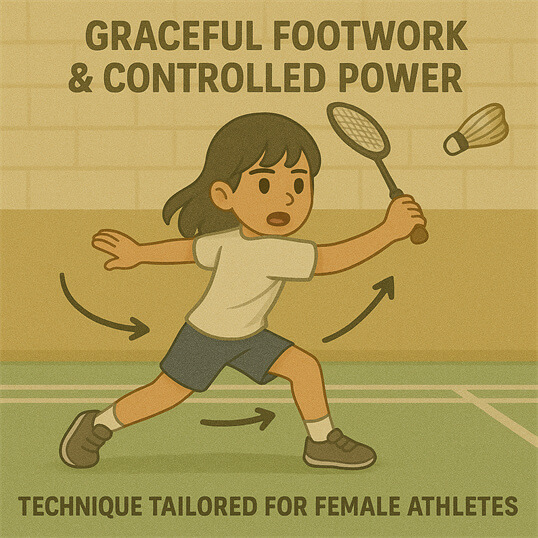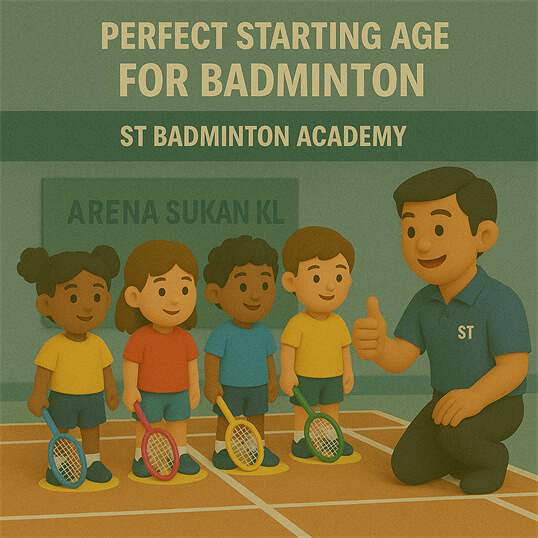Welcome to ST Badminton Academy’s badminton training in Malaysia! The lunge is an important move in badminton, but it can be difficult to master – especially if you’re just starting out. That’s why today I want to share some tips on how you can improve your lunge technique through targeted training exercises. Whether you’re looking for ways to refine your current technique or build your skills from the ground up, these strategies are sure to get you results.
Strengthening Your Core
As a badminton player, having the right lunge technique is essential to achieving success in the game. It’s not just about being able to move quickly and powerfully around the court – your posture and form must also be correct for you to perform at an optimum level. And that starts with building strength and conditioning drills that focus on strengthening your core muscles.
The core muscles play a key role in providing stability when lunging during rallies or serving – this makes them vitally important for any serious badminton player looking to take their game up a notch. To strengthen these muscles, I recommend doing exercises such as planks, squats, and bridges regularly.
This will help increase power transfer from your legs into your arms through proper body alignment which is necessary for executing powerful lunges without sacrificing accuracy of movement.
Additionally, dynamic stretching can improve mobility by increasing both ranges of motion and flexibility throughout all areas of the body involved with lunging; this further helps with energy efficiency while moving around the court too.
No matter how much time you spend training specific techniques like footwork or arm movements; if you don’t have strong core muscles then your performance won’t reach its full potential. Focus on building strength through regular exercise so that you can make sure each lunge is performed correctly every single time. This way you’ll be well prepared no matter what situation arises on the court…
Increasing Flexibility
Now that you have strengthened your core muscles, it is time to focus on improving flexibility and mobility. Improving flexibility can help badminton players move more quickly and efficiently when lunging for shots. Proper stretching and increased mobility will prevent injuries from occurring during the game.
A good way to increase your flexibility is by doing dynamic stretches before a match or practice session. Examples of these types of stretches are leg swings, arm circles, torso rotations, lateral shuffles, high knees, and body-weight squats. Each stretch should be done slowly and with control as opposed to bouncing through them. You should also take breaks in between each set of exercises to avoid overworking yourself too much at once.
After completing dynamic stretches, static stretching can be incorporated into the routine as well. Static stretching involves holding a stretched position for 30 seconds or longer while maintaining proper form throughout the exercise.
These stretches target key muscle groups such as the hamstrings, quadriceps, calves, glutes, lower back, and shoulders which will allow for an improved range of motion on the court. Make sure to breathe deeply during each hold so that your muscles can relax even further into their lengthened positions.
By taking the time to properly warm up with dynamic and static stretching routines prior to playing badminton you will notice an improvement in your lunge technique due to increased mobility and flexibility in your joints and muscles. This not only enhances performance but also reduces injury risk significantly allowing you to stay safe while pushing yourself further on the court. Now let’s look further into how balance and coordination can be improved with training drills..
Improving Balance And Coordination
Improving balance and coordination in badminton is like a game of chess: it requires strategy, planning, and practice. To hone your lunge technique, you must start with improving stability and coordinating movements. One way to do this is by doing core exercises such as sit-ups or planks to strengthen the muscles around your abdomen, lower back, hips, and legs.
This will help build strength for better stabilization during lunges. Additionally, practicing dynamic stretching before playing can also improve mobility and range of motion – an essential component for any badminton stroke.
Another great way to work on coordination is by engaging in agility drills that involve quick changes of direction while maintaining control over your body. For example, lateral bounds are a great exercise to help develop explosive power while keeping your feet under control.
You can also try ladder drills which focus on developing footwork speed and accuracy at the same time; these drills will challenge both physical performance as well as cognitive ability when done correctly.
Finally, there’s no substitute for good old-fashioned practice! Incorporate various badminton shots into short intervals of high-intensity training sessions, focusing on moving quickly from one shot to another without sacrificing accuracy or form.
As you practice more often, you’ll be able to increase the complexity of each drill until eventually, you’re able to execute every move with precision – just like a master tactician! With proper practice comes improved posture – something we’ll discuss next.
Practicing Proper Posture
I’m here to share my expertise on the badminton lunge technique and how you can improve it through training. The first step is practicing proper posture. Keeping your head up, shoulders back and arms bent are key components in obtaining a successful lunge.
You want to ensure that your body weight stays centered while lunging so you don’t overextend yourself or put too much pressure on one side of your body. Proper breathing techniques will help with this as well; take deep breaths throughout the exercise and focus on maintaining correct form.
The second component of improving your badminton lunge technique is developing proper footwork. Timing plays an integral part when executing a lunge properly; make sure that each movement is calculated before committing to them fully -this will keep you from slipping or missing the ball completely.
Your feet should be wide enough apart for balance but close enough together for agility during quick changes of direction if necessary. Practice makes perfect! Keep repeating the motions until they become second nature and remember to stay relaxed at all times.
Once you have mastered these two elements, then comes the fun part: putting it into play! This means applying what you’ve learned in actual matches against opponents which will give you instant feedback on where improvement is needed. Don’t get discouraged by any mistakes made along the way – simply use those experiences as learning opportunities for growth and success moving forward!
Developing Proper Footwork
Good footwork is the foundation of any successful badminton lunge. It’s like a dancer: if your feet are in the wrong places, you won’t be able to move gracefully or efficiently. That’s why it’s so important to develop proper footwork for a better badminton lunge technique through training.
One way I recommend doing this is by focusing on drills that improve your stride length and quickness. Start with basic forward and backward movements, such as hopping from side to side with one foot and then the other. This will help build up your agility, which allows you to reach farther when lunging after shots during a match. As you become more comfortable with these drills, add in lateral movement exercises and even shuffling back and forth while holding a racquet or shuttlecock.
These simple steps can make all the difference in how well you perform during playtime! With regular practice, you’ll find yourself covering more ground than ever before – giving you an edge over opponents who don’t take the time to hone their skills. Now let’s move on to training your lunging mechanics…
Training Your Lunging Mechanics
When it comes to improving your badminton lunge technique, there are several important aspects you need to focus on. I’m here to help guide you through the process and make sure that you’re executing every step correctly.
First and foremost, powering lunges is essential for any successful lunge. You’ll want to be sure that your feet positioning during a lunge is solid and secure in order to ensure maximum power output when propelling yourself forward. To do this:
Certainly! Here’s the information formatted into a table:
| Step | Instructions |
|---|---|
| 1. | Make sure both of your feet are firmly planted on the ground. |
| 2. | Have one foot slightly further back from the other with your weight resting mostly on the back leg. |
| 3. | Push off with both legs together while bending at the knee. |
| 4. | Thrust your body forward into a full extension. |
This table presents a clear breakdown of the steps involved in powering lunges with detailed instructions for each step.
The second key component of effective lunging involves proper foot placement. Foot placement can make all the difference between an unsuccessful jump or dive compared to a powerful attack. Be mindful of where you’re placing your feet upon landing as well as how quickly they move throughout each movement – whether it’s jumping, diving, or recovering after an attacking shot. Here’s what to keep in mind:
Certainly! Here’s the information formatted into a table:
| Step | Instructions |
|---|---|
| 1. | Maintain balance by keeping both feet shoulder-width apart. |
| 2. | Distribute weight evenly between both feet when settling onto them. |
| 3. | Don’t let either foot slide backward or forwards too far until ready for takeoff again. |
| 4. | Coordinate jumps and dives so that you always land softly but powerfully on both feet. |
This table provides a clear overview of the key points to consider for proper foot placement during lunging, whether it involves jumping, diving, or recovering after an attacking shot.
By mastering these two components of the lunging technique – powering yourself effectively and maintaining good foot placement – you will have taken great strides toward becoming a better player! With practice and dedication, you’ll soon be able to perform perfect lunges time after time, allowing you to take advantage of attacking opportunities whenever they arise. Now we turn our attention to improving another aspect of playing badminton – reaction time…
Improving Your Reaction Time
I’m a badminton training expert, and I’m here to help you improve your reaction time. One way to do this is by increasing your agility. This can be done through drills and exercises which focus on your quickness and balance. To enhance your coordination, practice drills that require you to hit the shuttlecock with multiple strokes in a row.
Strengthening your muscles is also key; by doing exercises that target your core, legs and arms, you’ll be able to make quicker and more powerful lunges. With regular practice and dedication, you’ll be able to improve your reaction time and become a better badminton player.
Increasing Agility
Hey there badminton lovers! Are you looking for ways to improve your lunge technique? Well, I’m here to help. Increasing agility is a key component of improving reaction time in badminton and can be achieved through various stretching exercises and dynamic warm-ups.
The first step is to perform some light stretching such as arm circles or leg swings before engaging in any high-intensity drills. This prepares the muscles for more strenuous movements by increasing their flexibility. It also helps prevent injuries from occurring during practice sessions.
Additionally, incorporating dynamic warm-up activities into your routine will help increase muscular strength & power while helping reduce fatigue during long matches. Examples include jogging on the spot, burpees, jumping jacks, and squats – all of which are great at raising heart rate and stimulating muscle activity prior to playing.
Finally, with regular practice and dedication to training, you’ll soon see significant improvements in your agility levels – allowing you to react quickly when lunging toward shots on the court! So go ahead and give these tips a try today – they’ll definitely make a difference in your game!
Enhancing Coordination
Now that you’ve got the basics of improving your agility down, let’s talk about enhancing coordination. Coordination between muscles is essential in order to respond quickly and accurately when lunging toward shots on the court. The key here is practice: by regularly working out with a partner or coach, you can begin to synchronize your movements and make them more efficient.
This will help develop better balance and body control while executing lunge movements during badminton matches. To get started, try drills such as footwork exercises (jumping jacks, shuffle steps, etc.) which will help build muscle memory for each move. These drills are great for increasing agility too – so it’s a win-win! With regular training sessions and dedication, you’ll soon see an improvement in your reaction time and be ready for any shot thrown at you!
Strengthening Muscles
Once you’ve established a routine of coordination exercises and drills, it’s time to move on to the next step: strengthening your muscles. Stretching exercises are key for increasing mobility in joints, while plyometric exercises will help build up strength. These can include jumping jacks and lunge jumps, as well as other bodyweight movements such as squats and burpees.
Make sure you find a balance between stretching and strengthening so that all areas of your body are receiving an equal amount of attention. This way, your reaction time when lunging toward shots will be improved even more! All these together form the ultimate foundation for badminton success; with dedication and hard work, you’ll soon see results!
Practicing Drills And Games
Having good reaction time is the foundation for any successful badminton player. However, honing your lunge technique takes more than just being quick on your feet – it requires practice and dedication to perfect this important skill.
That’s why I always recommend my students analyze their mistakes during drills and games. It’s essential to track progress by noting which strategies work best in different situations and make changes accordingly. Taking a step back to figure out what you did wrong can be difficult but ultimately makes all the difference when improving your lunge technique.
The key thing here is consistency; practice doesn’t make perfect, consistent practice does! Make sure you set aside regular time to train and continue refining your skills over time so that you can be at your best come game day.
Frequently Asked Questions

What Other Exercises Can I Do To Strengthen My Core?
If you’re looking to strengthen your core for a better badminton lunge technique, then there are other exercises that can help. Plyometric drills such as box jumps and squat jumps will engage the muscles around your core while improving speed and power.
Speed training is also important when it comes to strengthening your core; incorporating sprints or hill runs into your workouts will build up the strength in those areas. Additionally, make sure to use proper form during all of these drills, so that you don’t put extra strain on any part of your body.
How Often Should I Stretch To Increase Flexibility?
Stretching is an important part of any badminton training plan to increase flexibility. I recommend stretching multiple times per week, with a focus on dynamic stretches that involve movement like walking lunges and plyometric drills. Additionally, alternative stretches such as foam rolling can be beneficial in between workouts for more targeted areas. Overall, it’s important to maintain consistent stretching routines so you don’t lose the gains you’ve made from your hard work!
What Specific Exercises Can I Do To Improve My Balance And Coordination?
Did you know that 70% of badminton players lack the necessary balance and coordination to perform a successful lunge? Improving your stability, developing speed and agility are all key components for mastering the badminton lunge. As an experienced badminton trainer, I recommend incorporating specific exercises into your workout routine to improve in these areas.
These include single-leg step downs on a bench, lateral hops over cones or hurdles and box jumps with a focus on landing softly. By performing these drills regularly, you will be able to increase your stability and develop better coordination as well as improving overall performance during your next practice session or game.
What Types Of Drills And Games Should I Practice To Help Improve My Badminton Lunge Technique?
If you want to improve your badminton lunge technique, then focusing on footwork drills and shadow practice is key. Footwork drills help develop speed and agility, while shadow practice helps with coordination and accuracy.
Start by practicing basic lunges over a short distance first, gradually increasing the length of each step as you get better. You can also mix in some jumping jacks or other plyometric exercises for an added challenge. Finally, set up some simple games like target practice or hitting against a wall to take your skill to the next level!
How Can I Improve My Reaction Time When Lunging?
If you want to improve your reaction time when lunging in badminton, there are a few key elements you should focus on. Developing your footwork is essential – practice quick and decisive steps that will allow you to move around the court quickly and react faster. Strengthening your arms can also help as it’ll give you greater control of the racket during those crucial moments.
Other than choosing a good racket and also remember to choose the best racket restring in Malaysia. Additionally, drills such as shuttle runs and ‘lunge tag’ can be really beneficial for honing both your speed and lunge technique at once. Finally, don’t forget to take regular breaks so that your muscles stay fresh throughout training sessions.
Improve Your Badminton Lunge Technique in Badminton Training Malaysia
Lunging is an essential part of badminton and can make a huge difference in your performance. To improve your lunge technique, you need to focus on core strengthening exercises, stretching regularly for increased flexibility, improving balance and coordination with drills and games, as well as practicing reaction time drills.
With dedication and practice, you can become a better player by perfecting your lunges through training.
It may seem like a lot of work but the rewards are worth it! You will be able to move around the court more efficiently while being able to react faster to shots from opponents. By focusing on these techniques, you’ll soon find yourself dominating the game with confidence and skill – something that no amount of money or equipment could ever buy!





